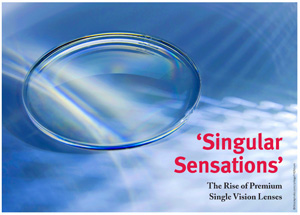RELATED CONTENT


By Andrew Karp: Group Editor, Lenses and Technology
NEW YORK—Until recently, the term “premium single vision lens” seemed like an oxymoron. Long considered a commodity, single vision lenses have changed very little in the past century. Apart from the introduction of aspheric surfaces in the 1990s and the increase in material, treatment and coating options, single vision lens optics have remained fairly static. Consequently, most single vision lenses are at parity in terms of optical performance, which has lowered prices and minimized profits for suppliers and eyecare professionals.
Over the past year, however, advances in digital design and manufacturing technology are bringing excitement to the single vision lens category. First used to produce progressive addition lenses (PALs), the technology, also known as free-form, is now trickling down and creating new performance capabilities for single vision lenses. New designs utilizing aspheric or atoric surfaces as well as a multitude of specialized designs now offer single vision wearers, like PAL wearers, an unprecedented degree of personalization. The new technology is elevating single vision lenses from commodity to premium status.
Although several spectacle lens suppliers—including Essilor, Shamir, Zeiss, Hoya and Rodenstock, have fielded premium single vision lenses, these advanced products represent only a small segment of the single vision category. Yet a growing number of dispensers are discovering that premium single vision lenses provide an opportunity to upgrade patients to a high performance product while generating significant profits. That alone makes these singular sensations a noteworthy addition to the market.
In the following article, dispensing expert Barry Santini surveys the current crop of premium single vision lenses and offers his perspective on how eyecare professionals can successfully integrate these products into their dispensaries. ■